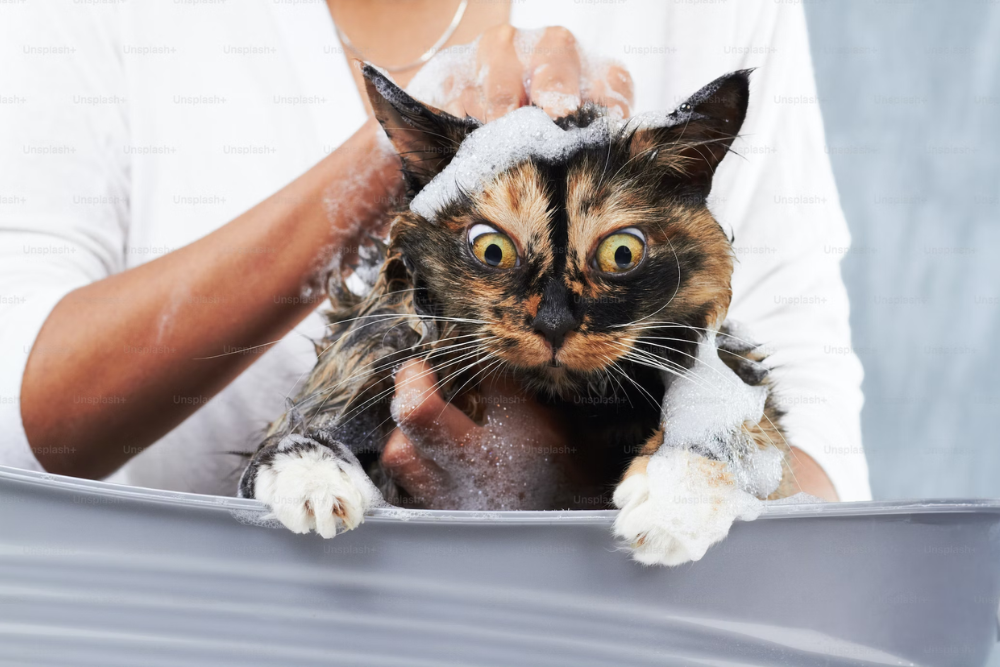Flea infestations are a nightmare for any cat owner, persisting year-round regardless of temperature. Spotting fleas or their eggs prompts the need for swift action. In this guide, we’ll delve into the essential steps of flea bath for cats, addressing common challenges and providing alternatives for feline friends who despise water.
Cat Fleas: Treatment and Prevention
Recognizing the signs of a flea infestation is the first step in effective treatment and prevention.
Identifying a Flea Infestation
Fleas are tiny, wingless insects that feed on the blood of their hosts, with cats being a common target. Detecting a flea problem involves observing your cat’s behavior and examining their fur. Scratching, biting, or excessive grooming are signs your cat may be dealing with fleas. Additionally, the presence of tiny black specks (flea dirt) on your cat’s skin or in their bedding is a telltale sign of an infestation.
Treatment Options
Choose Your Shampoo Wisely
Selecting an appropriate flea shampoo is crucial. Opt for a cat-friendly formula that targets fleas without causing irritation. Consult your veterinarian for recommendations based on your cat’s specific needs.
Application of Flea Medications
Topical treatments and spot-on medications are effective in preventing and treating fleas. These products are applied directly to your cat’s skin, providing long-lasting protection.
Flea Collars
Flea collars release chemicals that repel and kill fleas. Ensure the collar is the right size and consult your vet for advice on the most suitable brand for your cat.
Prescription Medications
For severe infestations, your veterinarian may prescribe oral medications. These are powerful treatments that work from the inside out to eliminate fleas.
Prevention Strategies
- Regular Grooming: Frequent grooming helps detect fleas early. Use a fine-toothed comb to comb through your cat’s fur, paying attention to areas like the neck and base of the tail where fleas often hide.
- Environmental Control: Regularly vacuuming your home, especially areas frequented by your cat, helps remove flea eggs and larvae. Wash your cat’s bedding in hot water to eliminate any hidden pests.
- Flea-Free Outdoor Spaces: If your cat spends time outdoors, consider using flea treatments designed for the yard. These can create a protective barrier, minimizing the risk of bringing fleas indoors.
- Consult Your Veterinarian: Regular veterinary check-ups are essential for your cat’s overall health. Discussing flea prevention with your vet ensures you’re using the most effective and safe methods for your specific cat.
Addressing Specific Challenges
If you have multiple pets, it’s crucial to treat all of them simultaneously. Fleas can easily transfer from one pet to another, leading to re-infestation.
Some cats may develop allergies to flea bites. If your cat exhibits signs of an allergic reaction, such as persistent itching or skin irritation, consult your veterinarian for appropriate treatment.
Effectively treating and preventing cat fleas requires a comprehensive approach. By choosing the right treatment, implementing preventative measures, and addressing specific challenges, you can keep your feline companion comfortable and flea-free. Regular veterinary guidance ensures that your chosen methods align with your cat’s health needs, creating a harmonious and pest-free environment for both you and your beloved pet.
How to Give a Cat a Flea Bath That Hates Water: A Gentle Approach

Bathing a cat that despises water can be a daunting task, especially when tackling the crucial process of flea treatment. However, with patience, preparation, and a gentle touch, it’s possible to make the experience less stressful for both you and your feline friend.
Stay Calm
Cats are intuitive animals that pick up on their owner’s emotions. Approaching the task with a calm and composed demeanor sets a positive tone for the experience. Take a few deep breaths, relax, and exude a reassuring energy.
Help Your Cat Get Used to the Water
Gradual exposure to water outside of the bath context can help your cat become more accustomed to it. Introduce shallow containers or play with water in a non-bathing scenario to familiarize your cat with the sensation.
Prep Everything Before the Bath
Before bringing your cat anywhere near the water, ensure all necessary items are within arm’s reach. This includes cat-friendly flea shampoo, towels, and a non-slip mat for the bath area. Being well-prepared minimizes the time your cat spends in the water, reducing stress.
Use Warm Water and Consider Small Tubs
Cats are sensitive to water temperature, so use warm water to make the experience more inviting. Opt for smaller tubs or basins instead of large, intimidating spaces. This provides a cozier environment, making the bath less overwhelming for your feline companion.
Be Careful While Bathing Your Kitty
Handle your cat gently throughout the process. Avoid sudden movements or loud noises that could startle them. Maintaining a calm and steady approach helps your cat feel secure and less anxious during the bath.
Alternatives If Your Cat Just Won’t Tolerate a Bath
Bathing a cat that adamantly refuses to tolerate water can be a challenging endeavor. If your feline friend vehemently resists traditional baths, fret not—there are alternative approaches to address flea concerns without subjecting your cat to a full-fledged bath. Here are effective alternatives to consider:

Topical Treatments
Explore spot-on treatments designed to be applied directly to your cat’s skin. These treatments typically come in the form of liquid drops that you apply between your cat’s shoulder blades. The active ingredients spread through the skin, providing targeted flea control without the need for a bath.
Flea Collars
Flea collars are another viable option for cats averse to water. These collars contain chemicals that repel and kill fleas, offering a convenient and non-intrusive method of flea control. Ensure the collar is the right size and consult your veterinarian for advice on the most suitable brand for your cat.
Oral Medications
For severe infestations or cats with an aversion to topical treatments, oral medications may be a suitable alternative. Consult your veterinarian to discuss prescription oral medications that effectively eliminate fleas from the inside out. These medications often provide long-lasting protection against fleas.
Flea Wipes
Flea wipes offer a gentle and water-free way to address fleas. These pre-moistened wipes are designed to be rubbed onto your cat’s fur, effectively removing and killing fleas on contact. While not as comprehensive as a bath, flea wipes can be a practical solution for cats that won’t tolerate water.
Sprays and Powders
Flea control sprays and powders provide yet another alternative for cat owners facing resistance to baths. These products can be applied directly to your cat’s fur, targeting fleas and preventing infestations. Follow the product instructions carefully and consult your veterinarian if you have concerns about specific products.
Professional Grooming Services
If all else fails, consider seeking the assistance of professional groomers who specialize in handling cats. Professional groomers have the expertise to manage difficult cats and can administer flea treatments efficiently. They often use techniques to minimize stress, ensuring a smoother experience for your cat.
Remember to consult with your veterinarian before trying any new flea control method, especially if your cat has pre-existing health conditions or is on other medications. By exploring these alternatives, you can effectively address flea concerns while respecting your cat’s aversion to water.
How to Give a Cat a Flea Bath Without Getting Scratched

Bathing a cat that is less than thrilled about water can be a challenging task, especially when aiming to administer a flea bath. However, with a patient and strategic approach, it’s possible to minimize the risk of scratches and make the experience more tolerable for both you and your feline friend.
Start Slowly
Introduce the concept of water gradually to acclimate your cat. Begin by allowing your cat to explore the bathroom or the bathing area without water. This helps them get used to their surroundings and reduces initial anxiety.
Turn It Into a Game
Make bath time a playful experience. Use toys or treats to create positive associations with the bathing area. Engage your cat in interactive play near the tub, slowly incorporating water-related elements into the game. This helps shift their perception of the bath from a negative to a potentially enjoyable activity.
Pretend It Is Not Happening
Approach the bath with a casual demeanor. Cats are sensitive to their owner’s emotions, and displaying a calm and nonchalant attitude can help keep the atmosphere stress-free. Avoid any sudden movements or signs of tension, as this can trigger anxiety in your cat.
Utilize Other Non-Bathing Options
If your cat vehemently resists the idea of a traditional bath, consider alternative flea control methods:
- Topical Treatments: Explore spot-on treatments that can be applied directly to your cat’s skin.
- Flea Collars: Use collars that release flea-repelling chemicals.
- Oral Medications: Consult your veterinarian for prescription oral medications for severe infestations.
These alternatives allow you to address flea concerns without subjecting your cat to a full-fledged bath.
Giving a cat a flea bath, especially one that hates water, requires patience and understanding. By approaching the task calmly, preparing adequately, and considering alternative flea control methods, you can ensure that your cat remains comfortable and stress-free throughout the process. Remember, a gentle touch and a positive attitude go a long way in making the experience more manageable for both you and your feline companion.
Frequently Asked Questions
What can I bathe my cat in to kill fleas?
You can use cat-friendly flea shampoos or consult your veterinarian for suitable alternatives.
Does Dawn kill fleas?
Dawn dish soap can be effective, but it’s best to use products specifically designed for cats.
How much is a flea bath for cats?
Flea bath costs vary; consult with your local groomer or veterinarian for pricing details.
Where to go for flea bath treatment for cats?
Contact your veterinarian or a reputable pet grooming service in your area for professional flea bath treatments.
Conclusion
Giving your cat a flea bath doesn’t have to be a daunting task. With the right approach, patience, and alternatives, you can effectively tackle fleas while ensuring your feline friend stays comfortable and happy. Remember, a calm and gentle approach goes a long way in making the experience stress-free for both you and your cat.


